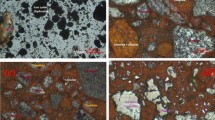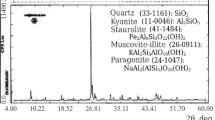Abstract
The primary aim of this study is the beneficiation of magnesite ores from eastern part of Iran by reverse flotation process. For this purpose, the mineralogical and microstructural characteristics of the as-received and the processed ores from Iranian Afzal Abad mine were established. The liberation degree of ore was estimated at about 75 µm. Then the as-received ore and the processed one were dead burnt to produce magnesia aggregates. These aggregates were used for production of shaped and unshaped refractories. Bricks and monolithic ramming mixes which were made from these aggregates were analysed and their mechanical and physical properties, studied. The results of this investigation showed that the application of reverse flotation process on the magnesite ore of eastern part of Iran causes an acceptable reduction on the amount of its siliceous inclusions, so that this type of the processed magnesia is suitable for utilization in the refractory industries. The magnesia produced from the original calcined ore was not suitable for this industry due to the presence of unacceptable amount of siliceous inclusions, which make its properties very poor.









Similar content being viewed by others
References
Ahmed I, Padhyang P K and Chandra D 1990 Res. Ind. 35 28
Aksel C, Kasap F and Sesver A 2005 Ceram. Int. 31 121
Bergeron C G and Risbund S H 1984 Introduction to phase equilibria in ceramics (Ohio: American Ceramic Society) p. 522
Birchal V S S, Rocha S D F and Ciminelli V S T 2000 Miner. Eng. 13 1629
Chen G and Tao D 2004 Int. J. Miner. Process. 74 343
Covacic D W R and Clarke J A 1991 Sampling equipment and techniques, part of the sampling of bulk materials (London, UK: Institution of Mechanical Engineering) p. 123
Dolatabadi M 2000 An introduction to east Iranian magnesite mines, Internal Report of Iran Refractory Materials Production Company, pp. 145
Gence N and Ozdag H 1995 Int. J. Miner. Process. 43 37
Golestani-Fard F 1997 Interceram 64 55
Golestani-Fard F, Fotouhi B and Marghosian V 1995 UNITECR 95 Japan refractory congress (Tokyo, Japan: Technical Association of Refractories) p. 202
Hoseini A 1988 Refractory raw materials (Tehran: Amir Kabir Publications)
Jankanovic V and Vumberkovic Z 1992 Interceram 41 87
Nishino T 1999 Taikabutsu Overseas 11 4
Othman A G M and Khalil N M 2005 Ceram. Int. 31 1117
Ozkan S G 2002 Miner. Eng. 15 99
Palco S and Riguad M 1993 J. Can. Ceram. Soc. 162 253
Palco S and Riguad M 2002 Metallurgy refractories and environment conference (Slovakia: Technical University of Kosice) p. 275
Ryder A 1993 Trans. Ind. Ceram. Soc. 52 88
Santana A N and Peres A E C 2001 Miner. Eng. 14 107
Shikano H 1998 Refractories handbook (Japan: Technical Association of Refractories) p. 127
Spencer D R 1978 First conference on refractory materials (London: The Institute of Refractories Engineers) p. 209
Yaghubpur A and Hassannejad A A 2006 J. Sci. I. R. Iran 17 147
Weiss N L 1985 SME Mineral processing handbook (Colorado, USA: Society of Mining Engineering of AIME) p. 14
Acknowledgements
The authors wish to express their appreciation for the technical support provided by Iran Refractory Material Production Company (IRMPCo.) and the laboratories of School of Mining Engineering, University of Tehran, School of Metallurgy and Materials Engineering, Iran, University of Science and Technology (IUST) and Khorasan Science and Technology park (Ceramic Pilot).
Author information
Authors and Affiliations
Corresponding author
Rights and permissions
About this article
Cite this article
ASLANI, S., BANI HASHEMI, H.R.S. & ARIANPOUR, F. Beneficiation of Iranian magnesite ores by reverse flotation process and its effects on shaped and unshaped refractories properties. Bull Mater Sci 33, 697–705 (2010). https://doi.org/10.1007/s12034-011-0150-0
Received:
Revised:
Published:
Issue Date:
DOI: https://doi.org/10.1007/s12034-011-0150-0




